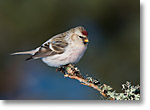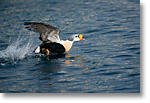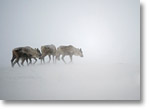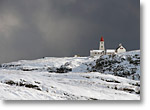|
It was that time of the year again. Where would this yearís annual bird photography trip take me? For the last 8 years, my trips have taken me up north to Finland and always in the depths of winter. There is something compelling about Finland or, I should say, Northern Scandinavia. Perhaps itís the light, the vast, empty spaces, and the sheer beauty of the countryside in the depths of winter. Itís all of that and, of course, the beautiful birds. I have never been disappointed, always coming home with good images: Pine Grosbeak, Cedar Waxwing, mating Golden Eagle, Crested Tit and Northern Bullfinch, just to name a few.
This year I felt it was time for a change and I was going to give Finland a miss. I decided to give Lesbos a go and the trip was booked. Unfortunately, the flights were cancelled without warning and, with no way of getting to the island, the whole Lesbos trip was off. An alternative needed to be found... and soon!
While browsing through Outdoor Photographer, a trip caught my eye: a week in early spring to the most northerly point of Europe, the Varangerfjord, to photograph the King Eider. A quick call and the trip was booked. Northern Scandinavia was again the itinerary!
The trip would take us from Ivalo, through Kaamanen to Batsfjord, and then further north to the small harbours of Vardo and Vadso in Norway. Standing on the shore at Vardo, there is nothing between one and the North Pole but an endless, cold and forbidding sea.
Northern Scandinavia in early spring is still a very cold affair. Forget snowdrops and daffodils - the scenery is dominated by snow and ice and is very unpredictable. It may be sunny one minute and then before you know it, it is snowing again! The first migratory birds will already be returning to their breeding grounds. The King Eiders will still be floating in the harbours of Vardo and Vadso, giving ample opportunities to photograph these birds.
The Quest Begins
At our first stop in Kaamanen, the hotel has a couple of bird feeders that attract typical boreal bird species like Pine Grosbeak, Siberian Tit, Siberian Jay, and Arctic and Mealy Redpolls. We are to stay here for two nights and will spend all our time near the birdfeeders. We already know that the Pine Grosbeaks are present and I am very excited at the prospect of photographing these beautiful birds. Pine Grosbeaks are not normally known to visit birdfeeders but it seems to be a habit they have developed over the last couple of years.
Just to be able to walk out of my hotel room and photograph these birds is a real luxury. No walking around with heavy equipment, and thereís a constant supply of coffee! The Pine Grosbeaks and Arctic Redpolls are abundant and we snap away the whole day. At the end of the day it snows quite heavily, but by that time we already have our fair share of good images. It really has been a very good day.
The weather is so good the next morning that we decide to stick around the hotel for a little longer to photograph the redpolls and grosbeaks. There has been a heavy frost overnight and the temperature is minus 17 Celsius! We use a wide variety of twigs to attract the birds and it is fantastic to photograph them in the soft early morning light.
On To The Eiders
Later that morning we set out on the long trek to Batsfjord for our first encounter with the King and Stellerís Eiders. I canít wait! Even so, we make a few stops along the road. Close to the Norwegian border, we encounter two Hawk Owls, perched high up on a pylon. The last part of the journey takes us through a beautiful Fell landscape and once we make our descent, we can see the stop for the next two nights: Batsfjord.
Batsfjord is a small fishing community and in the early spring, various duck species are present in the harbour. It doesnít take us long to find the first King Eiders, Stellerís Eiders and Long-tailed Ducks. Photographing them, however, isnít that easy. Tomorrow we are to take a boat into the harbour and photograph the ducks from a lower angle.
We head back to the hotel late that afternoon for our dinner. By the time we go to bed it is snowing heavily, though the forecast is good for the next day. Indeed, the next morning, the weather is great: sunny, and not too much wind. With King Eiders especially, we donít want too much light; exposing them correctly can be difficult because of the contrasting colours of the birds.
At 9:00 a.m., we board the boat that will take us around the harbour for the next 4 hours or so. The back of the boat is rather low, just above the waterline, providing excellent positions from which to photograph the birds. It is amazing to be among the eiders, ducks, and other water birds. The birds seem accustomed to boats, so they are not very shy. We take some good images and return to Batsfjord around noon. The afternoon is spent in the harbour looking for more photographic opportunities to make the best of the weather.
The Farthest Point North
In the morning, we make another long drive to the most northerly point of our expedition: Vardo. Here we can expect larger flocks of King and Stellerís Eiders. Generally they are further away from the harbour, which means another boat tour.
The weather is again beautiful, but there is not much time for photography. Although Batsfjord is, in geographical terms, not far from Vardo, there are no roads! So it means we have to take a circular route to Vardo, a 150-mile round trip. We try to find a Hawk Owl that we had spotted on the way in to Batsfjord but unfortunately the bird has disappeared. We do see two White-tailed Eagles perched along the Varangerfjord, but as soon as we open the door of the car, they fly off.
By noon, we arrive in Vardo. There is far less fishing activity here than in Batsfjord, one of the reasons why there are not that many Stellerís and King Eiders in the harbour. We do find a nice flock of Purple Sandpipers on the seafront and spend a considerable amount of time photographing them. They are the first waders to return from their wintering grounds further south and one has to ask what brings them back so early!
The following day, we take a boat tour out onto the Bering Sea. The weather looks promising when we meet at the boat. It really is a tiny ship and I am glad the weather looks favourable. It will be impossible to use tripods on the boat, so we have to handhold our lenses. I opt for the Nikon D3 and the 200-400mm VR.
After a 15-minute boat ride, we arrive at Hornoya, an island populated by sea birds. Although it is still too early for them to breed, a number of species have already returned from their wintering grounds. As we approach Hornoya, we see there are hundreds of guillemots, puffins, shags and ducks floating on the water. Over the top of Hornoya we see a White-tailed Eagle glide by, and ravens have started their displays.
The cameras are clicking away. It is an unbelievable experience and only witnessed by a few. Not many photographers visit Hornoya so early in spring. We move on and leave the shelter of the bay, heading for open sea. We had spotted a large raft of King Eiders the day before and we want to try to photograph them. The eiders have other ideas, though, and they take off from a great distance making it hard to get any decent images.
The boatman decides to let the boat ďfloatĒ and we get in much closer to the King Eiders this time. This gives us ample opportunities to photograph the birds, mainly in flight as they head in and out of the sound.
Then the weather makes a turn for the worse. The boatman tells us we have to head back to Vardo Harbour as soon as we can. An incredible snow blizzard blows off the pole and the sea becomes very turbulent. I can tell you that on this small boat it became rather hairy at times. We reach Hornoya where we have a bit more time to photograph the guillemots as they float on the water in this incredible blizzard. Soon we reach the harbour.
The afternoon is spent around Vardo tracking reindeer. We manage to find a number of them close by the road, giving us great opportunities to photograph them in these harsh spring conditions. I think this is what this part of Europe is all about: glorious weather one minute, a cold and hostile environment the next.
We head back to the hotel. Tomorrow we will try one more boat ride, hopefully with better weather conditions.
Last Days In The North
The next morning the weather looks much better but there is still a fair amount of wind. At 9:00 a.m., we assemble near the pier and set off for our second ďassaultĒ on Hornoya. Unfortunately, the birds are not as cooperative as yesterday. The auks and guillemots fly around but seem to fly much higher; still, there are enough photographic opportunities. A couple of Grey Seals circle the boat and ravens are flying overhead. It is quite a strange sight: shags sitting in the snow on the cliffs.
Then, like yesterday, the weather makes a turn for the worse and we head back to Vardo to pack. By the time we arrive back in the harbour it is snowing heavily again and the forecast is not very good. We have a long trip ahead of us, about 350 kilometres back to Kaamanen, where we will spend our last night.
We make frequent stops on the journey back and even manage to find a flock of waxwings, unexpectedly, as there are no trees with berries in sight for at least 200 miles! The further we get away from Vardo, the better the weather seems to get. With luck we might have some Northern Lights tonight.
We arrive back in Kaamanen early evening. We have a quick supper and then the waiting game for the Northern Lights starts. It is bitterly cold and the temperature drops to a minus 25 C! Around 9:00 in the evening, I decide to have a look at the night sky and I am greeted by the awesome display of the Northern Lights. It is truly a wondrous sight. With a rush, cameras with wide-angle lenses are mounted on tripods and we try to find some good spots around the hotel. Even though the moon is up, we capture some lovely images of the Northern Lights. By 10:00 p.m., the display dies down and we retreat to the warmth of our rooms. The cameras are covered with a thin layer of ice.
The next morning, the weather is gorgeous, cold, and bright and we spend another two hours at the feeders, snapping away at the redpolls, grosbeaks and Siberian Jays. It all comes to an end when we have to load our luggage into the car, which will take us back to the airport of Ivalo to commence our journey back to London.
Magical Place
It has been a fantastic week, the weather has been very good and I have been able to photograph many of the birds I was hoping to see. Truly, Finland in the winter is a magical place. Not many venture so far up north to Varangerfjord to photograph the wildfowl, but it is a special place and can be very rewarding.
My quest for the King Eider has come to a successful end, and, as I write this, I am already thinking about next year. Will I be drawn back to Northern Scandinavia for an eleventh venture? Only time will tell.
Comments on NPN bird photography articles? Send them to the editor.
Rene de Heer has been a nature photographer for 24 years. His main interest is bird photography, but given the chance, he will also try his luck with mammals and landscapes as well. Rene was the founder of one of the first Dutch Nature Photography Societies, which is still going strong today. His work has been widely published in magazines and calendars and he has participated in several successful exhibitions. More of his work can be seen at www.naturepics.co.uk.





